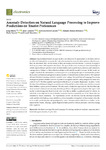Mostrar o rexistro simple do ítem
Anomaly Detection on Natural Language Processing to Improve Predictions on Tourist Preferences
| dc.contributor.author | Meira, Jorge | |
| dc.contributor.author | Carneiro, João | |
| dc.contributor.author | Bolón-Canedo, Verónica | |
| dc.contributor.author | Alonso-Betanzos, Amparo | |
| dc.contributor.author | Novais, Paulo | |
| dc.contributor.author | Marreiros, Goreti | |
| dc.date.accessioned | 2022-03-28T16:38:15Z | |
| dc.date.available | 2022-03-28T16:38:15Z | |
| dc.date.issued | 2022 | |
| dc.identifier.citation | Meira, J.; Carneiro, J.; Bolón-Canedo, V.; Alonso-Betanzos, A.; Novais, P.; Marreiros, G. Anomaly Detection on Natural Language Processing to Improve Predictions on Tourist Preferences. Electronics 2022, 11, 779. https://doi.org/10.3390/electronics11050779 | es_ES |
| dc.identifier.issn | 2079-9292 | |
| dc.identifier.uri | http://hdl.handle.net/2183/30297 | |
| dc.description | This article belongs to the Special Issue Advances in Explainable Artificial Intelligence and Edge Computing Applications | es_ES |
| dc.description.abstract | [Abstract] Argumentation-based dialogue models have shown to be appropriate for decision contexts in which it is intended to overcome the lack of interaction between decision-makers, either because they are dispersed, they are too many, or they are simply not even known. However, to support decision processes with argumentation-based dialogue models, it is necessary to have knowledge of certain aspects that are specific to each decision-maker, such as preferences, interests, and limitations, among others. Failure to obtain this knowledge could ruin the model’s success. In this work, we sought to facilitate the information acquisition process by studying strategies to automatically predict the tourists’ preferences (ratings) in relation to points of interest based on their reviews. We explored different Machine Learning methods to predict users’ ratings. We used Natural Language Processing strategies to predict whether a review is positive or negative and the rating assigned by users on a scale of 1 to 5. We then applied supervised methods such as Logistic Regression, Random Forest, Decision Trees, K-Nearest Neighbors, and Recurrent Neural Networks to determine whether a tourist likes/dislikes a given point of interest. We also used a distinctive approach in this field through unsupervised techniques for anomaly detection problems. The goal was to improve the supervised model in identifying only those tourists who truly like or dislike a particular point of interest, in which the main objective is not to identify everyone, but fundamentally not to fail those who are identified in those conditions. The experiments carried out showed that the developed models could predict with high accuracy whether a review is positive or negative but have some difficulty in accurately predicting the rating assigned by users. Unsupervised method Local Outlier Factor improved the results, reducing Logistic Regression false positives with an associated cost of increasing false negatives. | es_ES |
| dc.description.sponsorship | This work was supported by the GrouPlanner Project under the European Regional Development Fund POCI-01-0145-FEDER-29178 and by National Funds through the FCT—Fundação para a Ciência e a Tecnologia (Portuguese Foundation for Science and Technology) within the Projects UIDB/00319/2020 and UIDP/00760/2020 | es_ES |
| dc.description.sponsorship | Portugal. Fundação para a Ciência e a Tecnologia; POCI-01-0145-FEDER-29178 | |
| dc.description.sponsorship | Portugal. Fundação para a Ciência e a Tecnologia; UIDB/00319/2020 | |
| dc.description.sponsorship | Portugal. Fundação para a Ciência e a Tecnologia; UIDP/00760/2020 | |
| dc.language.iso | eng | es_ES |
| dc.publisher | MDPI | es_ES |
| dc.relation.uri | https://doi.org/10.3390/electronics11050779 | es_ES |
| dc.rights | Atribución 4.0 Internacional | es_ES |
| dc.rights.uri | http://creativecommons.org/licenses/by/4.0/ | * |
| dc.subject | Machine learning | es_ES |
| dc.subject | Natural language processing | es_ES |
| dc.subject | Sentiment analysis | es_ES |
| dc.subject | Argumentation-based dialogues | es_ES |
| dc.subject | Tourism | es_ES |
| dc.subject | TripAdvisor | es_ES |
| dc.title | Anomaly Detection on Natural Language Processing to Improve Predictions on Tourist Preferences | es_ES |
| dc.type | journal article | es_ES |
| dc.rights.accessRights | open access | es_ES |
| UDC.journalTitle | Electronics | es_ES |
| UDC.volume | 11 | es_ES |
| UDC.issue | 5 | es_ES |
| UDC.startPage | 779 | es_ES |
| dc.identifier.doi | 10.3390/electronics11050779 | |
| UDC.coleccion | Investigación | es_ES |
| UDC.departamento | Ciencias da Computación e Tecnoloxías da Información | es_ES |
| UDC.grupoInv | Laboratorio de Investigación e Desenvolvemento en Intelixencia Artificial (LIDIA) | es_ES |
Ficheiros no ítem
Este ítem aparece na(s) seguinte(s) colección(s)
-
Investigación (FIC) [1656]






